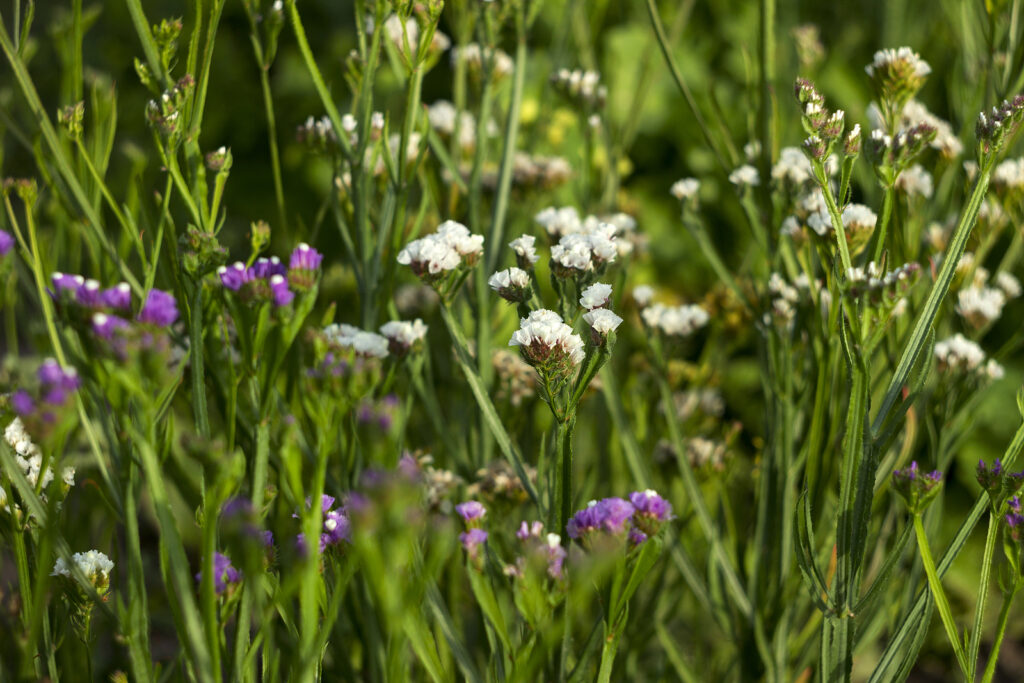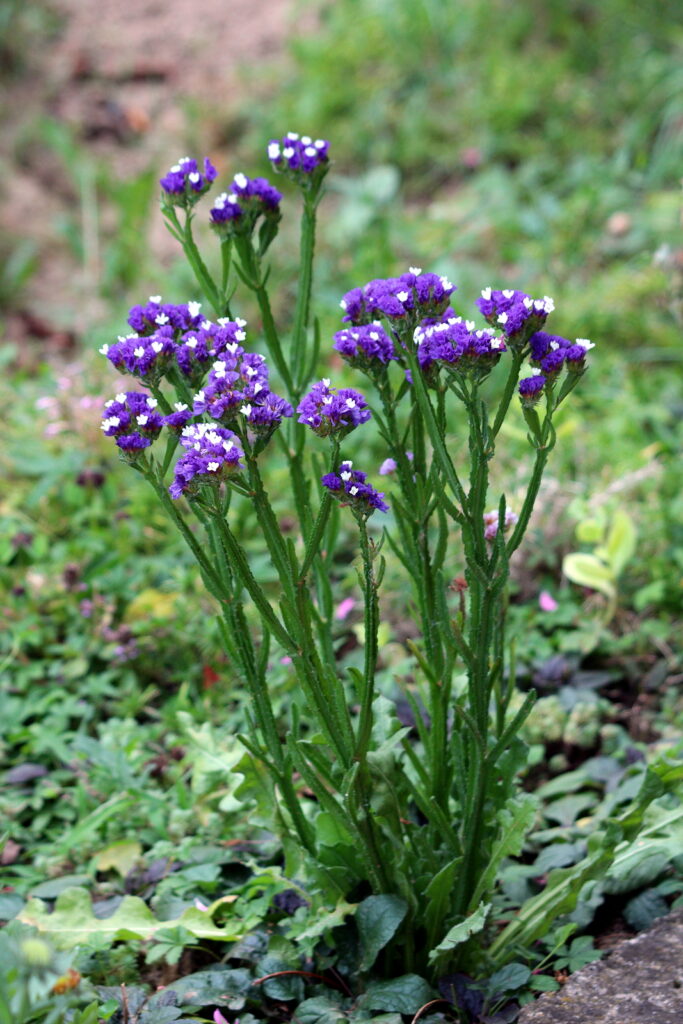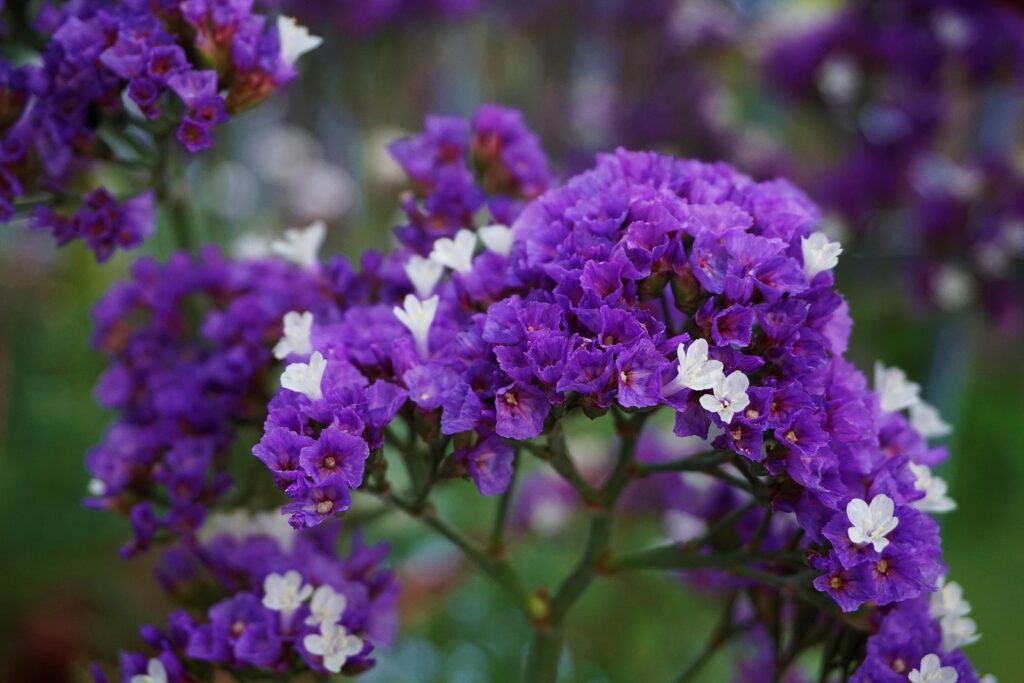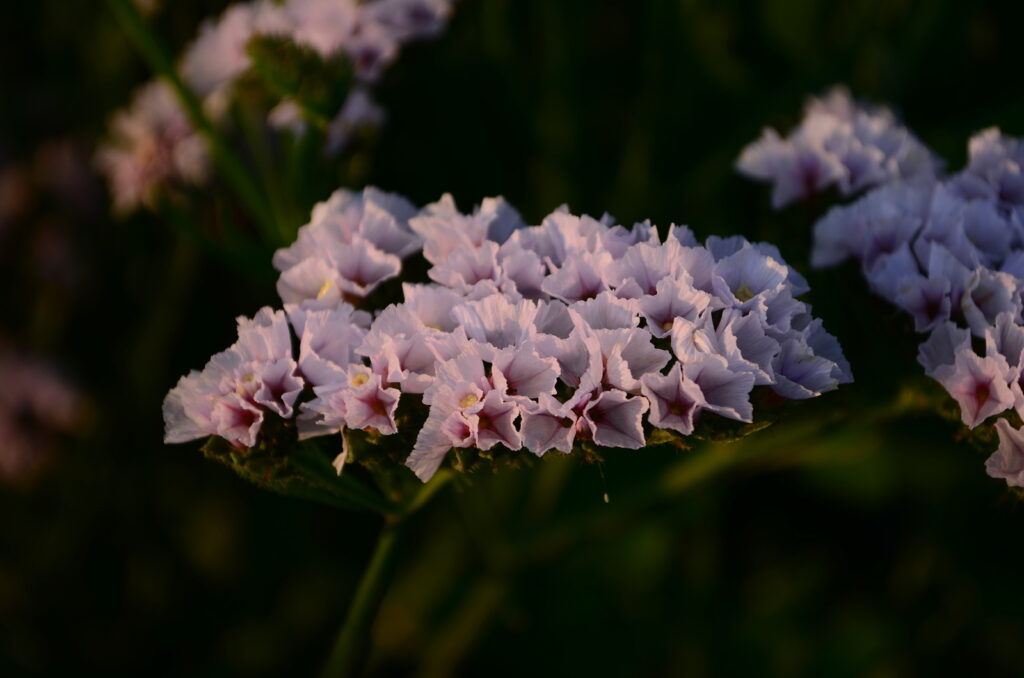Limonium species are commonly known as sea lavender or statice. Statice is the former botanical name for this genus of 150 species of perennials, biennials, and annuls.
Limonium–commonly called statice–bears small spiked or clustered flowers in summer. Flowers have a papery texture and can be white, yellow, rose, lavender, or blue. Plants form a basal rosette of oval, wavy-edged green foliage. Leaves sometimes turn red in autumn. Statice is salt- and cold-tolerant; it grows well in coastal gardens.
Perennial and annual varieties of static are good plants for sandy soils and seaside gardens. Statice is also an ideal choice for cutting gardens and makes excellent dried flowers.
Flower Garden Success Products at Amazon:
- Wildflower Seed Mix Attracts Hummingbirds and Butterflies
- Eden Brothers All Perennial Seed Mix
- 10 pcs Stainless Steel Garden Hand Tool Set
- Gorilla Cart 4 Cu. Ft, 300-pound Capacity
- Neem Bliss 100-% Cold Pressed Neem Oil
- Safer Brand Insect Killing Soap

Get to know Limonium
- Plant type: Perennial, also biennials and annuals
- Growing Zones and range: All zones an annual or biennial; Zones 3 to 11 a perennial depending on the variety
- Hardiness: Hardy to -35°F (-37°C); tolerant of heat, cold tolerance depends on the species
- Height and width: 12 to 36 inches (30-91cm) tall and wide
- Foliage: Deeply lobed, lance-shaped leaves form a rosette at the base of the plant
- Flowers: Airy mass of funnel-shaped flowers in long clusters; papery flowers are 1/4 inch across and borne in flat-topped clusters
- Flower colors: Blue, lavender, white, rose, yellow, apricot, and peach
- Bloom time: Mid- to late summer
- Uses: Seaside plantings, visual texture
- Garden companions: Ornamental grasses, fall color, cut or dried flowers
- Common name: Statice, sea lavender
- Botanical name: Limonium spp.
- Family: Plumgaginaceae
- Origin: Coasts and salt marshes worldwide
Where to plant Limonium
- Plant Limonium in full sun; perennial statice may need some shade in Zones 8 and warmer.
- Grow Limonium in sandy, well-drained soil.
- Limonium prefers a soil pH of 5.5 to 7.
Limonium uses and companions
- Grow Limonium at the front of a bed or border.
- Limonium is a good cut flower; the papery flowers can be cut fresh or dried; cut before the flowers are fully open.
- Good garden companions for Limonium are Eryngium, Euphorbia, Gaura lindheimeri, Lobelia laxiflora, Nepeta, Oenothera.

When to plant Limonium
- Set Limonium in the garden in spring after the danger of frost has passed.
- Start seeds indoors 8 to 10 weeks before setting plants outdoors.
- Sow seeds outdoors in smoothly prepared beds after all danger of frost has passed.
- Set container-grown plants outdoors after all danger of frost has passed, after hardening off several days in the shade.
Planting and spacing Limonium
- Sow seed indoors in individual pots or flats filled with sterile seed starting medium.
- Plant seeds 1/8 inch deep, water and keep warm at 70° to 75°F (21°-24°C); seeds will germinate in 15 to 20 days.
- Grow seedlings in bright sunlight or a few inches below a fluorescent light; transplant seedlings to individual pots when they have two sets of true leaves.
- Perennial and biennial species can be sown outdoors in late fall or early spring; sow seeds outdoors 1/4 inch deep.
- Space Limonium 24 inches (61cm) apart.

How to water and feed Limonium
- Limonium needs moderate moisture; keep the soil evenly moist.
- Fertilize Limonium every 6 weeks with an all-purpose fertilizer or work in a slow-release fertilizer each spring.
Limonium care
- Stake tall statice varieties as needed.
- Limonium is very tolerant of salt spray and is a good plant for seashore gardens.
- Removing spent flowers encourages prolonged bloom.
- To dry Limonium for flower arrangements, cut stems when flowers are fully open and hang them in bunches upside down in a cool, dry place.
Limonium pests and diseases
- Rust, leaf and flower spots, and gray mold can be a problem.
- Southern blight and crown rot are common.
Good Products for Seed Starting Success at Amazon:
- Jump Start Germination Station w/Heat Mat Tray, 72-Cell Pack, Dome
- Espoma Seed Starting Mix
- 200 Count- Jiffy 7 Peat Soil Seed Starting Plugs
- Seed Starter Kit with Humidity Dome (120 Cells Total Tray)
- AgrobriteT5 Fluorescent, 2-Foot, Grow Light System
Limonium propagation
- Limonium is propagated by division or seed.
- Seeds germinate in 14 to 21 days at 75° to 80°F (24°-27°C).
- Divide Limonium in spring by digging up the small side rosettes that form at the plant’s base; replant divisions immediately

Limonium varieties to grow
- Annual statice grows in Zones 2-11; use it for drying.
- Limonium latifolium is a perennial for Zones 3-9; grows 24 to 36 inches (61-91cm) tall and has lavender, blue, white, or pink flowers.
- L. perezii is a perennial for Zones 8-11.
- L. sinuatum: this species is an annual or biennial that has white, blue, lavender, or red flowers; it grows 12 to 30 inches (30-76cm) tall.
- L. suworowii, Russian statce. Grows to 18 inches; well-branches, curved spikes of bright rose or lavender flowers.
Limonium frequently asked questions
Q: Can I start sea lavender (Limonium) from seed?
A: Yes. Start Limonium (sea lavender) seeds indoors 6 to 8 weeks before the last frost or sow seeds in the garden just after the last frost. Perennial sea lavender can take as long as three years before the plant flowers. In the garden, Limonium sometimes self-sows. Limonium commonly does not like being transplanted.
Q: Is Limonium difficult to grow?
A: Limonium is not difficult to grow. Limonium wants full sun and well-drained soil. It is hardy to -40°F.
Q: How long does Limonium bloom?
A: Limonium–sea lavender–grows to 18 inches tall and 12 inches wide and bears sprays of tiny lilac flowers for about 8 weeks during the summer. It is a good choice for the front of a border or in a rock garden. The flowers can be used in fresh or dried arrangements.



